|
|
|
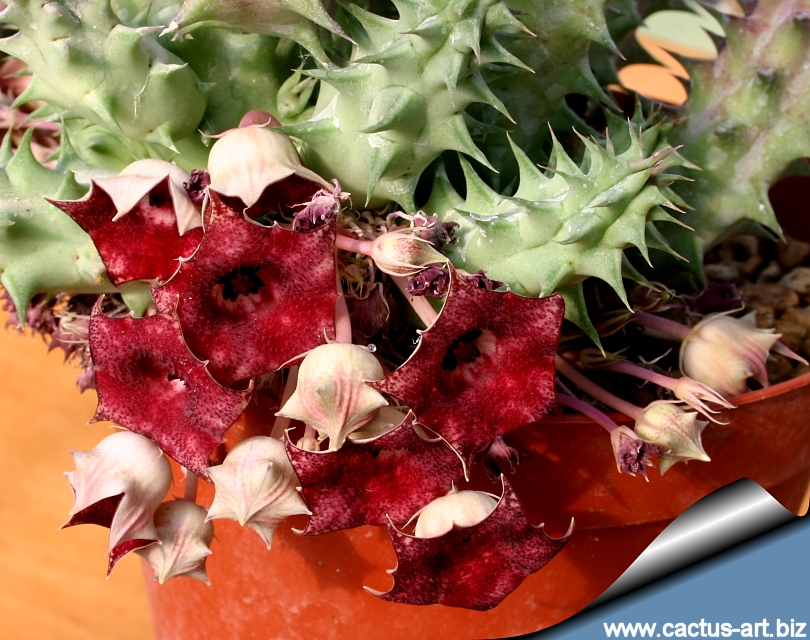
Huernia macrocarpa
(Formerly:
Huernia macrocarpa v. schweinfurthii) |
|
|
|
Etymology:
The
genus
name "Huernia" is named
after the missionary Justus Heurnius
(note the spelling of the genus name is wrong!) who introduced
the first stapeliads in Europe in the XVII century.The
species name
"macrocarpa"
derives from the Greek
adjective
“macros (μακρος) ” meaning "big,
long; tall,
high, deep, far
”
plus "o" (connective
vowel used in botanical Latin, usually for Greek words) and
“carpos (καρπος) ” meaning
"fruit" followed by the
latinizing suffix
"us"
. (The specific name implies:
“large fruited”) |
|
|
|
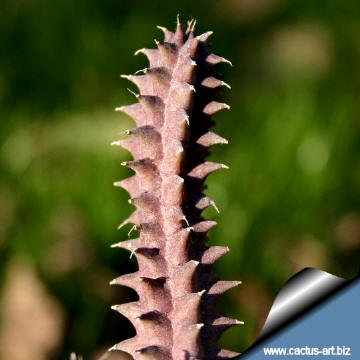
Purple tone of a stem during winter rest.
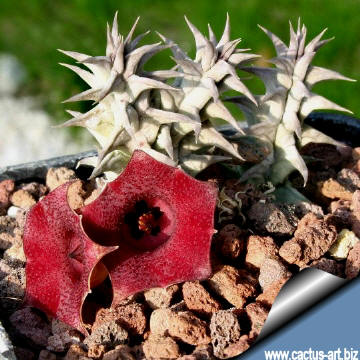
Colour intensity of flowers is variable, even on the same
plant |
Description: Small
clumps of
basally
branching stems that to
spread sideways
or trail and will rapidly fill an entire pot.
Stem: About the length of a finger 9-25 cm long (rarely
growing taller than four to 20 cm),
fleshy,
glaucous,
cylindrical just at the
base then
subquadrangular;
angles coarsely
toothed;
teeth
fleshy 7-8mm. long, 3-4mm. thick at the
base,
acute,
recurved,
spinescent at the
apex,
separated by
sinuses
along the stem angles 6 to 8mm. wide.
Flower: 1 to several from the
base of young stems
typical 5
lobed,
Pedicel:
5mm. long, pale green
glabrous.
Sepals:
10mm. long, 1mm long at the
base, gradually tapering to
a very fine
hairlike point,
glabrous.
Corolla:
Campanulate,
somewhat more than 1cm. Long, and 2cm. at the greatest diameter;
lobes broadly
triangular,
acute, whit an intermediate point
hardly 1mm. long in the flat
sinuses between; outside
greenish-yellow, prominently 5-nerved, minutely
papillate,
glabrous; inside everywhere except in lower portion of
tube
covered with little
bristle-like
processes becoming smaller
toward the
apex of the
lobes, creamy-yellow marked with deep
purplish-crimson
concentric broken lines, narrowly
marginates on
lobes with same colour and a spot of same at the
sinuses;
tube broadly
Campanulate, about 7mm. deep;
lobes 6mm. long,
7mm. broad, slightly spreading,
deltoid,
acuminate, not
ciliate.
Outer corona: Very shortly 5-lobed,
velvety
purplish-crimson; lobes transversely oblong,
emarginated.
Inner corona: Lobes broad at the base,
tapering to a
subobtuse point, very minutely
pubescent ,
connivent and rising slightly above the
anthers, purplish whit
yellow knobs at the base.
Phenology:
Blossoming time:July-October
|
|
Frost Tolerance: It is usually recommended to
overwinter them in warm conditions (at 10 deg) but despite the African
origin they seem to grow well and flower without the extra heat which
one might have thought necessary and occasional temperature near 0 deg.
are tolerated if kept dry.
Potting medium: Since roots are quite shallow, use
a
cactus mix or add extra
perlite or
pumice to regular soil
potting soil. A gritty, very free-draining
compost is suitable, and
clay pots help the plants to dry out between watering.
Pest and
diseases: Huernia species vary in their
susceptibility to
rotting, but are generally fairly easy to grow, especially
if kept
pest-free. They are very
susceptible to stem and root
mealy bugs, and damage from these may well initiate
fungal
attack. If you do have problems with a stem or with basal
rotting, you can reliably isolate the healthy parts, dry them off,
and re-root them in moist compost. |
|


Advertising
|
|
|
|
Family:
Asclepiadaceae
(Apocynaceae) (Milkweeds family)
|
Scientific Name:
Huernia macrocarpa
(A.
Richard) Sprenger 1892
Published in: Dammann: Cat., 4. 1892
Basionym:
Stapelia
macrocarpa A. Richard 1851
Published in:
Tentamen
Flora Abyss., ii. 50. 1851
Vernacular names
comprise: Starfish flower, carrion
Plant |
| The species Huernia
macrocarpa is now a complex grouping of plants that has recently
been expanded to include amongst others Huernia arabica,
H. penzigii, H. macrocarpa v
schweinfurthii, and H. macrocarpa v cerasina.
|
|
Distribution: This plant came from Ethiopia
but the members of the enlarged complex
”macrocarpa” has a ample distribution encompassing Sudan,
Eritrea, Ethiopia, Saudi Arabia and Yemen
Habitat: Grows on granite rocks
|
|
|
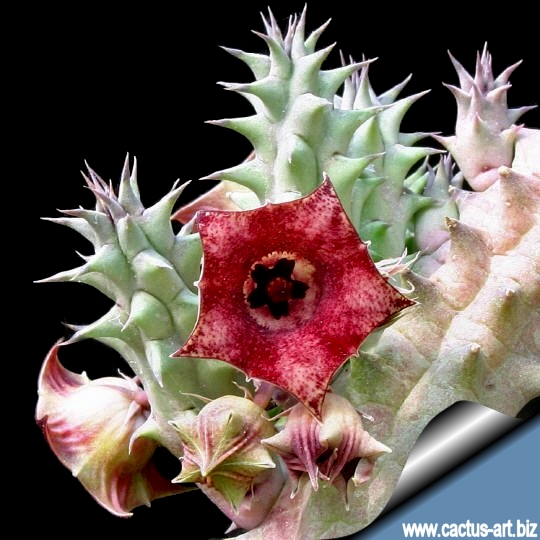 |
|
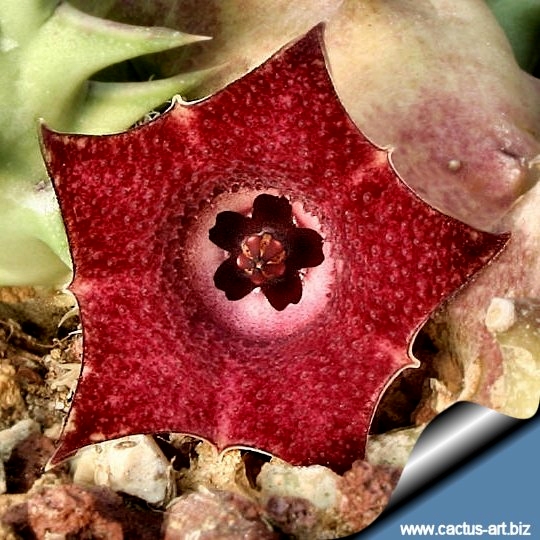
Outer
corona velvety
dark purplish-crimson with transversely oblong
lobes
,
emarginated.
Inner corona:
Lobes broad at the base,
tapering to a
subobtuse
point, purplish whit
yellow knobs at the base. |
|
|
Cultivation:
Not difficult to grow. Huernia require moderately watering
through the
growing season but enjoy plenty of water and some
fertiliser in hot
weather, this helps them to
flower freely. Water more sparingly in winter according to
temperatures. But, as with most
asclepiads, it is unwise to leave them wet in cold weather.
Propagation: Easiest with stem
cuttings. Allow cuttings to
dry a day before
planting. Stems must be laid (Not buried) on
gritty
compost and will then
root from the underside of the
stems. It can also be increased from seeds
sowing in
spring in moist,
sandy
peat moss. Barely cover seeds. Seeds
germinate quickly.
|
|